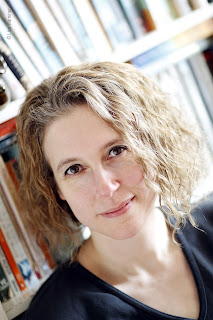Samantha Hunt was born in 1971 in Pound Ridge, New York. Her
first novel, The Seas, (2004) a
twisted tale of mermaids, won the National Book Foundation's Five under
Thirty-five prize. Her second novel about Nikola Tesla, The Invention of Everything Else (2008) was a finalist for the
Orange Prize and winner of the Bard Fiction Prize. Hunt’s work as been
published in The New Yorker, McSweeney’s, the New York Times, Tin House,
A Public Space, Cabinet, Blind Spot, the London Times and in a number of other
publications. Her books have been translated into ten languages. She lives in
Tivoli, New York, and teaches at the Pratt Institute in Brooklyn.
Her latest book, a contemporary gothic novel, Mr Splitfoot, has been described as ‘literary gold’ (Sunday Express). ‘Her every sentence
electrifies’ (Kelly Link).
‘Mr. Splitfoot is lyrical, echoing, deeply strange, with a
quality of sustained hallucination. It is the best book on communicating with
the dead since William Lindsay Gresham's Nightmare
Alley, but it swaps out that novel's cynicism for a more life-affirming
sense of uncertainty’. (Luc Sante, author of Low Life)
Nat and Ruth are young orphans, living in a crowded foster
home run by an eccentric religious fanatic. When a traveling con-man comes
knocking, they see their chance to escape and join him on the road, proclaiming
they can channel the dead - for a price, of course.
Decades later, in a different time and place, Cora is too
clever for her office job, too scared of her abysmal lover to cope with her unplanned
pregnancy, and she too is looking for a way out. So when her mute Aunt Ruth
pays her an unexpected visit, apparently on a mysterious mission, she decides
to join her.
Together the two women set out on foot, on a strange and
unforgettable odyssey across the state of New York. Where is Ruth taking them?
Where has she been? And who - or what - has she hidden in the woods at the end
of the road?
Ingenious, infectious, subversive and strange, Mr Splitfoot will take you on a journey
you will not regret - and will never forget.
1. Tell us of your journey as a
writer
First I wrote a lot of bad stuff. A whole lot of bad stuff,
probably ten years of bad writing. I copied people whose work I admired. Then
after banging my head against the wall enough, my writing got a little bit
better. Now, I work very hard. I revise endlessly.
2. How do you see your role as a
writer and what do you like most about it?
I enjoy the extremes of writing: total solitude at one
extreme to a wide and deep immersion in the world. I also enjoy having a job
that allows me to ask and try to answer questions that pester me. I really
enjoy the feeling that there is nothing I am not curious about.
3. Have you ever created a character
who you dislike but find yourself empathising with?
I empathize with all of my characters. Even the nastiest
ones. Evil doesn’t occur without a reason and weakness is general. Creating
characters with weaknesses is my specialty.
4. Last October, GW organised
#diverseauthorday. What has been your experience of writing about characters of
colour?
In drafting a character, color is not something I usually
consider. I’d rather leave that open to the reader. Indeed, a number of readers
have told me that they see Ruth from Mr. Splitfoot and her whole family as
African-American. Other readers have thought she is white. The characters I
create with color in mind — I’m thinking of Colly from Mr. Splitfoot—I do so in
order to make a comment on racism in America, a topic no American writer can
avoid.
5. If you could be transported instantly, anywhere in the
world, where would you most like to spend your time writing? And why?
It is hard for me to write when I’m away from home. I need
to feel alone in order to write which means I need for my kids to be doing
something they enjoy enough that they’ll let me be, but if they are doing
something too interesting, I’ll want to do it too. Still, I spent last winter
in Barcelona with my family and it was a very productive writing time. I
finished a piece about One Direction and death that I’d been thinking about for
a long time. Read more here.
6. What is the one book you wish you had written?
As I Lay Dying (1930) by William Faulkner
7. What advice do you have for would be novelists?
I wrote my first novel by writing 250 short pieces that were
all about the ocean and life in small towns. I then spread the pages out on the
floor and shaped them into a skeleton for a narrative. Then started to smooth
and revise. This is a good way to approach a first book as it is manageable.
Write one small piece you like each day.
8. What are you currently working on? What can we look
forward to reading?
I have multiple projects in the works. It helps me to write
this way because when I start to doubt, or tire of one project, I can turn my
attention to the next project. So, upcoming I have a collection of stories
titled Beast. I’m finishing the last story now. I am also working on a book of
non-fiction that examines the way in which people get haunted. I am also
working on a new novel, but I am sorry, I find that if I talk about novel
projects before they are done, they have a tendency to never get done.
Thanks for your questions!
You can follow Samantha on Twitter: @samanthajhunt







